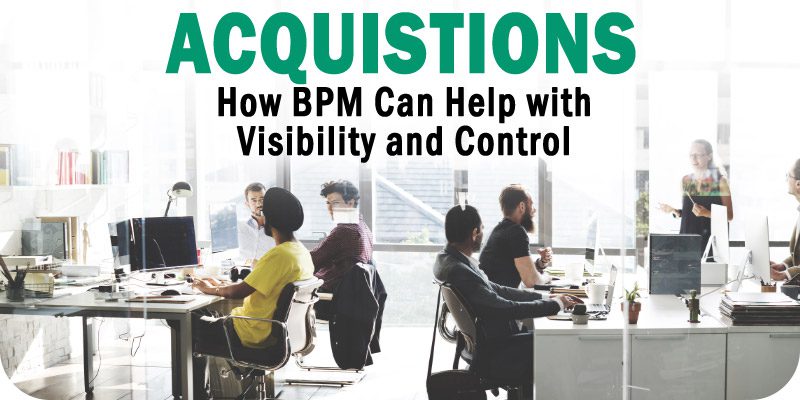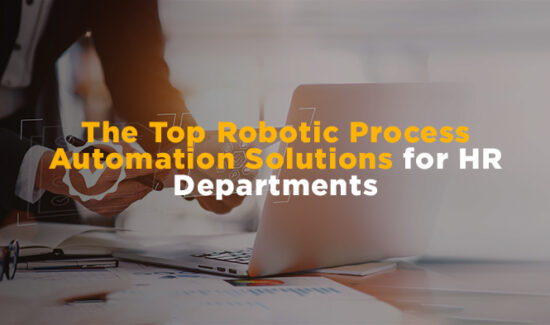How Can BPM Help You Gain Visibility and Control During an Acquisition?


As part of Solutions Review’s Premium Content Series—a collection of contributed columns written by industry experts in maturing software categories—Mike Fitzmaurice, the Chief Evangelist and VP of WEBCON, shares insights on the value BPM software can bring to company acquisitions.
 Companies are on a massive buying spree. In 2021, global M&A activity totaled $5.9 trillion, an increase of 64-percent year over year. Some speculate that this spike can be attributed to pandemic-enhanced scrutiny of business portfolios, whereas others are sure that its causes are related to talent shortages and growth aspirations. Whatever the reason, acquisitions offer businesses more funds, product offerings, talent, and sales channels.
Companies are on a massive buying spree. In 2021, global M&A activity totaled $5.9 trillion, an increase of 64-percent year over year. Some speculate that this spike can be attributed to pandemic-enhanced scrutiny of business portfolios, whereas others are sure that its causes are related to talent shortages and growth aspirations. Whatever the reason, acquisitions offer businesses more funds, product offerings, talent, and sales channels.
Yet, many companies are also discovering that acquisitions can be disruptive to their business. One of the biggest challenges is integrating and transitioning IT infrastructure and systems. If the organization is a serial acquirer, its IT department can juggle multiple acquisitions simultaneously or in short order. Similarly, until the integration is complete, both organizations may lack transparency, visibility, and control over crucial things like spending and compliance.
Using Process Management to Streamline Acquisitions
When two organizations are integrated, there will inevitably be significant differences in processes, policies, and systems that companies have to work through. But where should they start? How can they make the transition as smooth as possible? I’d argue that you begin with the process, which, by definition, dictates how work gets done. And wouldn’t you know it, there’s a whole software category for Business Process Management (BPM).
Specifically, regarding acquisitions, you want low-code BPM tools. These can help you add a workflow-based layer to facilitate the integration and orchestration of existing systems (e.g., ERP, CRM) for a unified digital workplace. The benefit of BPM during an acquisition is twofold. First, it helps companies understand a subsidiaries’ existing processes to identify any differences from its own. Second, it provides a roadmap for rolling out changes and new systems to the company they are acquiring. This ensures every employee, regardless of location or role, is working from a single source of truth and makes it easier for management to make decisions based on the whole picture. Some simple examples are outlined below.
Contracts
BPM can help companies identify the workflows used to negotiate deals and sign contracts, and identify opportunities to streamline. Companies can answer questions like:
- Who must review this data?
- Who approves and signs?
- Is this information consistent across business groups?
As an added benefit, better process management also gives the company a central view of procurement across subsidiaries to improve group buying power.
Cost approval
By creating a unified digital workplace to approve all costs electronically, a company gains visibility across subsidiaries, allowing them to see exactly what they are spending, invoice by invoice. This is extremely important in an acquisition, as trust levels aren’t yet established.
Compliance
BPM also helps companies gain visibility to ensure that all subsidiaries meet compliance requirements across territories and regions (for instance, GDPR in Europe), significantly reducing operational risk.
Example: How an Office Furniture Manufacturer Maneuvered a Series of Acquisitions
Nowy Styl, a European furniture manufacturer, leverages acquisitions as part of its sustained growth strategy, which helps it increase manufacturing and extend its sales network. Each purchase means updating processes and replacing or integrating systems. One of the most important is the enterprise resource planning (ERP) platform. While Nowy Styl uses IFS as its ERP global standard, the company they acquire might be using Microsoft Dynamics, SAP, or even just a different version of IFS. Replacing an existing ERP system is not easy; it requires time and effort across multiple business areas.
One central pain point is adding new products to IFS. Producing a single chair, for instance, creates 1,700 different options for Nowy Styl (wheels, lumbar support, armrests, etc.). Every combination must be named with the same product index in every system and factory. This means describing the product in the same categories as their other products. Sometimes, an acquisition results in 40,000 new products, which takes many weeks to evaluate and categorize the entire engineering team.
To overcome these challenges, Nowy Styl decided to take a low-code BPM approach beyond business applications that support back-office processes (rallying around a standard “paperless organization” theme) and shop floor activities. Thanks to this process-oriented approach, Nowy Styl has slashed the time needed to transition other ERP systems over to IFS, so product engineers can quickly move to other tasks.
Instead of tackling product line integration and categorization as a massive project, Nowy Styl built a low-code application that checks if a product is already in IFS any time a new production order is created. If it is, the process continues smoothly. If it isn’t, the engineer responsible for the specific product gets assigned a task to categorize it. This just-in-time integration ensures engineers are only given work that needs to be done immediately to fulfill a production order.
Building different applications from a single software delivery platform significantly reduce costs and risk and enables the IT department to deliver and evolve low-code solutions on the fly. This has resulted in building various applications that benefit the business. For instance, Nowy Styl has created process workflows that enable them to re-route production orders from one factory to another. Suppose production orders are stacked up at the factory that typically produces the required office furniture, and they cannot build it in time. In that case, Nowy Styl has the flexibility to create it at another factory instead.
BPM has helped Nowy Styl improve its acquisition processes from end to end, saving time for the IT and engineering teams, giving leadership complete visibility into crucial business areas, and significantly reducing costs across departments. Rather than representing a disruption that takes months, acquisitions are now something Nowy Styl is building its business on.























